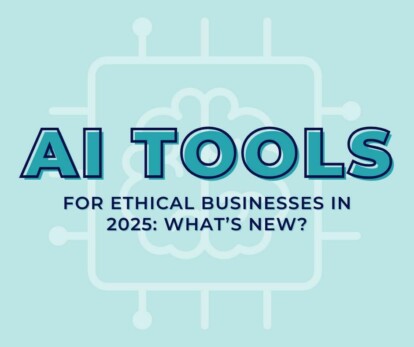What is food justice?


Back in June 2024, we published an article that explored how AI tools were transforming ethical businesses, from streamlining admin tasks to generating content.
Less than a year later, the AI landscape continues to shift – so it’s time for an update!
If you’re running a vegan business or organisation, it can be hard to keep up. New tools are emerging daily. Language models are getting smarter. And the latest big development – AI agents – promises to take automation to a whole new level.
This blog will help you:
Before we dive into the latest AI developments, it’s worth pausing.
Many people are still wrestling with the ethics of using AI. These are real and valid concerns – and they matter.
AI systems aren’t always kind to the planet. Training large models can use significant amounts of energy and water. Many have been built using content created by human writers, artists, and researchers – sometimes without consent. Copyright, plagiarism, job displacement, and creative ownership are all part of the conversation.
But even knowing this, AI isn’t going away.
Like the internet or social media, it’s becoming part of how the world works – whether an individual loves it or not.
Using AI doesn’t have to be an all-or-nothing proposition. You can thoughtfully engage with AI tools, guided by your values. You can experiment with one small task. You can decide what you’re comfortable with.
And you can say no to anything that doesn’t feel right.
AI has evolved rapidly over the past year, and it would be almost impossible to highlight every change, headline, or new tool.
For those of us running ethical organisations, some of the most important developments include:
AI tools now understand images, audio, video, and text. You can ask them to describe a photo, edit a voice memo, or suggest leaflet layouts.
Many platforms you already use – like Gmail, Canva, Notion, and Shopify – now have AI built in. You can draft content, tidy data, or brainstorm product names without needing to switch tools.
Instead of giving AI a prompt and getting a reply, you can now give it a goal – and let it figure out the steps. The systems that perform in this way are called AI agents.
For brilliant, non-techy explanations of what an AI agent is:
Watch: “What Is an AI Agent?” – Jeff Su (YouTube)
Read: Google Cloud’s Beginner Guide to AI Agents
Let’s look at this in more detail.
Until recently, most AI tools have been reactive – you type a prompt (the input), and the AI gives you a response (the output). Or you set up automated workflows that need you to tell the system exactly where to look and what to do, step by step.
AI agents take this further.
An AI agent is a type of tool that can reason and take actions (ReAct), not just generate responses, all with minimal or no human intervention once they’ve been set up.
You don’t have to give an AI agent detailed instructions. You simply explain the outcome you want, and the agent works out how to get there.
If previous AI tools have acted like an assistant, an AI agent is your project manager.
AI agents can:
Some can even run as autonomous workers in the background, monitoring trends, preparing reports, or replying to customers.
For example, a vegan supplement business might use an inventory management AI agent to monitor stock levels, reorder ingredients, and send weekly updates to the founder. A sanctuary could ask an agent to compile newsletters, summarise donation reports, and suggest social media posts, based on your own tone and past content.
It’s easy to assume AI will “just work”; in reality, the quality of the output often depends on the quality of your input. Whether you’re using a simple chatbot or a more advanced AI agent, your prompts and guidance matter.
Let’s take a quick example:
A vague prompt:
Write a blog about vegan skincare.
A more useful prompt:
Write a friendly, informative blog post (600–800 words) for people looking to transition to vegan skincare. Include five practical tips, mention cruelty-free certification, and encourage small swaps. Use UK spelling and avoid sensational language.
The second version gives the AI more to work with and helps it produce something that sounds like you.
This matters even more when using AI agents. These tools don’t just answer a question – they reason, act, observe, and refine their responses. But to achieve this, they need direction, context, and (ideally) access to your own materials.
Think of them like a new team member: you wouldn’t expect someone to do their job well without first showing them how you do things. An AI agent may need the same instructions and data.
If you run a vegan café and want help replying to customer enquiries, you might provide an AI agent with your brand tone, allergy policy, sample replies, product list, latest offers, calendar, and any links or resources you normally send out.
You can often upload this info or paste it directly into a prompt when setting up the agent.
If that sounds like a lot, here’s the good news: many tools (like ChatGPT Plus) are starting to remember your preferences across sessions. If you tell ChatGPT that you’re a small vegan business that uses locally sourced plant-based ingredients and wants to keep a warm but professional tone, it can now recall that information next time you log in, making it feel more like a consistent assistant than a blank slate.
You don’t need to be a tech expert to get started.
Just be as clear and specific as possible about what you want, what you value, and how you’d like the AI to behave. The more you shape the input, the more helpful and trustworthy the output becomes.
AI agents are cropping up everywhere, so you may be wondering where to start. A few well-chosen tools can help you explore what’s possible, one step at a time. We suggest checking out:
One easy place to start is within ChatGPT Plus, which now gives you access to Custom GPTs.
These are personalised versions of ChatGPT tailored for specific tasks like writing emails, planning content, or helping with pricing.
You can browse and use GPTs that others have created or build your own by giving it instructions about your business, tone of voice, and goals. It’s a simple way to create an AI assistant that works more like you.
For example, you could use a Custom GPT for your vegan business that’s trained to draft content in your brand tone, respond to common customer questions, or suggest blog ideas based on ethical themes.
You can explore the growing library at chat.openai.com/gpts.
Not ready to dive into custom GPTs? You can still use regular ChatGPT (or Claude) to act like an agent by giving it a clear prompt, such as:
You are my ethical business support agent. Your job is to help me respond to customer questions and manage weekly content planning. I’ll feed you updates and tone guidelines. Ask questions if you need more info.
This gives you a chance to explore AI’s potential without needing to set up anything complex.
If you want to see the mind-blowing variety of AI agents already available or even find agents to use in your business, you might want to try:
Over the past year, AI has become more useful (and more accessible) across a range of business tasks, even if you don’t have a tech background.
Here are some areas where AI might save you time or help you do more with less:
Need flyers for an event, graphics for your website, or fresh visuals for your socials?
AI image tools like the one built into ChatGPT), Ideogram, and Leonardo.Ai can generate on-brand visuals from a simple text prompt.
For example:
Create a poster for a vegan bakery pop-up shop with bold fonts, a green and cream colour scheme, and cartoon-style illustrations of cakes.
You can also use them for background images, mock-ups, or logos. Tools like Ideogram enhance prompts automatically – you can refine the results further if needed.
(AI image tools are still very much a work in progress, especially with images that feature text, so there are limitations!)
AI tools like Grammarly Pro, Notion AI, and Google Docs’ Help Me Write features can help you improve clarity, adjust tone, or rewrite something for a new audience.
If you want something more structured and tailored for values-led businesses, you could try Marketing Magic by Menekse Stewart. It’s an AI-powered content creation tool designed for purpose-driven entrepreneurs – helping you generate ethical marketing messages, blog post outlines, email sequences, tell your brand story, and more, without compromising your tone or values.
If you create content for podcasts, videos, or courses, AI tools like Descript and ElevenLabs can help with editing and voice work.
If you receive lots of similar enquiries – like “Are your products gluten-free?” or “When will my order arrive?” – an AI-powered chat widget can help.
Tools like Tidio, Botpress, and Manychat can be trained on your FAQs, policies, and brand voice to answer customer queries on your website or social media 24/7. You stay in control and can step in for more complex conversations when needed.
This can be especially helpful if you’re a solo business owner or juggling multiple roles. (Options range from free to pricey, so you’ll need to look around for the best solution for your business and budget.)
Understanding what’s happening across your website, socials, orders, and campaigns can be tricky, especially when the data lives in lots of different places.
AI tools like Rows and Swydo let you build simple dashboards that pull in data from Google Analytics, Shopify, Instagram, and more – then help you track trends, spot patterns, and make better decisions.
They often include natural-language querying, so you can ask things like: “What were my best-performing products last month?” or “Which day had the most newsletter clicks?”
You don’t have to use all of these – or even more than one. But knowing what’s possible can help you spot small, meaningful changes that free up time, reduce repetitive tasks, and let you focus on the heart of your work.
If you’re interested in AI, here are some resources that can help you keep up with what’s happening in this lightning-fast field (even if you’re not techy):
AI can be messy, exciting, and overwhelming, all at once!
You don’t have to do everything with AI. You don’t have to let it shape your values. But you can use it in small, helpful ways. You can test what works for you. And you can stay curious without compromising what matters.
This isn’t about being “for” or “against” AI. It’s about using the tools that serve your mission – and making space for rest, creativity, and connection with your community and our animal kin.
And while most of us are focusing on small, practical uses in our businesses, it’s worth remembering that AI is also developing in areas like medical research where it could one day reduce or replace the use of our fellow animals in testing.
It’s another reminder that technology, when used with care and intention, can support the kind of world we’re all working toward.
(How we used AI to support this blog: We used ChatGPT to help us plan the outline for the article and pinpoint key points to research. We then asked it to give examples of good and bad AI prompts in various scenarios and used it as a search engine, in addition to Google. Finally, we asked it to critique the article – one suggested revision was that we cut a section on AI in medicine, but mention it in the conclusion instead, as it wasn’t relevant to the main topic!)